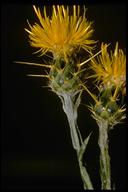 Scientific
Name: Centaurea
solstitialis
Scientific
Name: Centaurea
solstitialis Common Name: yellow star thistle
 Scientific
Name: Centaurea
solstitialis
Scientific
Name: Centaurea
solstitialis Steams and leaves: There are sharp spines around the base of stems. The stems of the plant are rigid, stems .6 to 1 meter tall, spreading out over the ground going all the way to the top of the plant. The leaves and steams have a cotton fuzzy hair on them making them appear whitish. The basal leaves are 2-3 inches long and deeply lobed. On the upper leaves are shorter with fewer lobes. The overall shape of the leaves is narrow and longer than most thistles. (2,3,5,6).
Flowers: The plant's flower color is in yellow. Around the base there are sharp spines that are about 1 ½ inches long (3.75 cm long). These spines make it a distasteful dinner for animals. In fact, the plant is deadly to many animals. The shape of the flower is urn shaped or circle shaped. (1-6).
The Environments That are Favorable for Infestation: Deep loamy soils. On south facing slopes with rainfall of 12-25 inches a year. The weed likes to take over land that has blue bunch wheat grass, Idaho fescue, and cheat grass. However, it won't take over land from sage brush. It will grow in arid to semiarid lands, and abandoned cropland. (1,3,5,6).
Seeds: The seeds are formed in the place where the flower blooms which is called the seed head. They are like a dandelion; there are seeds that are formed with a parachute like tissue at the top which allows for wind dispersal. There is also a second type of seed that does not have the parachute. (2,4).
Spread: The plant spreads by seeds that drift in the wind with their own form of nature's parachute. (1,2,5).
CONTROLS
Chemical:
The best chemical control is a pint per acre of
Tordon
22K. (7)
Cultural:
Reintroducing native grasses. Also introducing
competitors.
1. Grasses that are perennials.
2. Bunch grasses and creeping grasses are the most
desirable
ways to control it culturally. (1-7)
Biological:
Some of the biocontrol agents are:
Bangasternus orientalis
Eustenopus villosus
Urophora sirunaseva
These are weevils that in their different stage eat the
plant's seed
heads, stems, and roots (2,7)
Life style: This plant is an annual that spreads mostly by seeds. (4)
Impacts: This weed is only a potential danger
for
Montana
but it has completely taken over California and is also
a problem
in Idaho. (4,6) The plant has a toxin that paralizes the
mouths
of horses and can kill them. (1)
3. "Yellow Starthistle, Centaurea Solstaitialis L." Montana Weed Control Association. http://www.mtweed.org/Identification/Starthistle/starthistle.html
4. Lym, Rodney G. "Yellow Starthistle Identification
and
Control." North Dakota State University. http://www.ext.nodak.edu/extpubs/plantsci/weeds/w1222w.htm
5. Clark, Jack. "Yellow Starthistle." Yolo Country Resource Conservation District. http://www.yolorcd.org/weeds/yellow_starthistle.shtml
6. "Yellow Starthistle Weed Alert." Pest Managment. Ministry of Agriculture and Lands. http://www.agf.gov.bc.ca/cropprot/starthistle.htm
7. Breitenfeldt, Todd, Personal Interview, Biology Teacher,
Whitehall
Schools, Box 1109, Whitehall, Mt 59759, (406) 287-3862,
9-1-99.